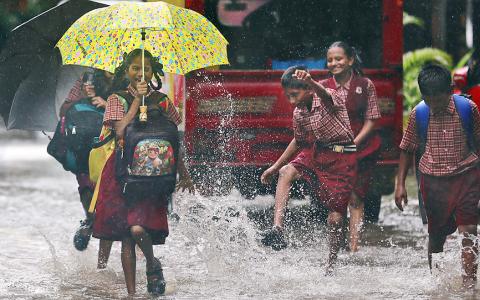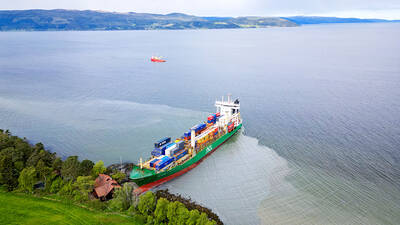Each year as temperatures rise across India, farmers look to the sky and pray for rain.
The all-important monsoon forecast becomes a national priority, with more than 70 percent of India’s 1.25 billion citizens engaged in agriculture and relying on weather predictions to decide when they will sow their seeds and harvest their crops.
However, getting the forecast right remains a challenge, thanks to the complex — and still poorly understood — ways in which South Asia’s monsoon rains are influenced by everything from atmospheric and ocean temperatures to air quality and global climate trends. Even the amount of ice in Antarctica is suspected to have an impact.

Photo: AP
And it is only getting harder to figure out, scientists say, as the monsoon becomes increasingly erratic.
A new study released on Friday in the journal Science Advances helps clear up a bit of the mystery, by showing that human-induced climate change is responsible for most of the change seen in ocean surface temperatures near the equator across Asia, which in turn affect regional rainfall patterns including the Indian monsoon.
By showing that link, the study indicates future ocean warming in the region, which could in turn increase the amount of rainfall during monsoons, strengthen cyclones and increase precipitation over East Asia.
“This has important implications for understanding changes in rainfall patterns for a large, and vulnerable population across Asia,” said oceanographer Evan Weller, who led the research team while he was at Pohang University of Science and Technology in South Korea, before recently shifting to Monash University in Australia.
The study looks specifically at a mid-oceanic body called the Indo-Pacific Warm Pool, which holds some of the world’s warmest seawaters and spans the western Pacific Ocean to the eastern Indian Ocean.
Scientists have long known that India’s monsoons are partly influenced by that warm pool. And they have known that the pool has been expanding — and warming — for decades. That expansion and warming have already caused some sea rise around islands in Asia.
It was not entirely clear why the pool was changing, until now.
Weller and his team compared data observations with several climate models, and deduced that rising greenhouse gases along with aerosols and other atmospheric pollutants were the dominant cause of the pool’s warming and expansion over the past 60 years, though regional climate variations also had some effect.
“This was not entirely surprising. We have long suspected climate change to be behind the changes, but no one had yet proven it,” Weller said.
What they did not expect was to find that the western portion of the pool, near India, was expanding more than the eastern part in the Pacific.
“We don’t really know why. We’ll try to figure that out next,” Weller said.
However, one thing is clear: If climate change trends continue, and by most indications they will, forecasters will have to consider the warm pool in their monsoon predictions. And by demonstrating how greenhouse gases are the dominant driver of changes in the warm pool, the team has added another dimension that can help improve climate models.
Asia, in general, could face significant consequences from this trend: more storm activity over East Asia, and stronger South Asian monsoons between June and September.
That sounds like good news for water-scarce India, but probably is not. Most of that rain would likely fall before the monsoon front reaches land. Already, studies by the Indian Institute of Tropical Meteorology show a declining trend in precipitation over land.
Anxious to improve its forecasting, India is investing at least US$43 million through next year to buy more powerful computers and better technology that can help specialists make more accurate calculations and models of seasonal weather forecasts.

Polish presidential candidates offered different visions of Poland and its relations with Ukraine in a televised debate ahead of next week’s run-off, which remains on a knife-edge. During a head-to-head debate lasting two hours, centrist Warsaw Mayor Rafal Trzaskowski, from Polish Prime Minister Donald Tusk’s governing pro-European coalition, faced the Eurosceptic historian Karol Nawrocki, backed by the right-wing populist Law and Justice party (PiS). The two candidates, who qualified for the second round after coming in the top two places in the first vote on Sunday last week, clashed over Poland’s relations with Ukraine, EU policy and the track records of their

UNSCHEDULED VISIT: ‘It’s a very bulky new neighbor, but it will soon go away,’ said Johan Helberg of the 135m container ship that run aground near his house A man in Norway awoke early on Thursday to discover a huge container ship had run aground a stone’s throw from his fjord-side house — and he had slept through the commotion. For an as-yet unknown reason, the 135m NCL Salten sailed up onto shore just meters from Johan Helberg’s house in a fjord near Trondheim in central Norway. Helberg only discovered the unexpected visitor when a panicked neighbor who had rung his doorbell repeatedly to no avail gave up and called him on the phone. “The doorbell rang at a time of day when I don’t like to open,” Helberg told television

‘A THREAT’: Guyanese President Irfan Ali called on Venezuela to follow international court rulings over the region, whose border Guyana says was ratified back in 1899 Misael Zapara said he would vote in Venezuela’s first elections yesterday for the territory of Essequibo, despite living more than 100km away from the oil-rich Guyana-administered region. Both countries lay claim to Essequibo, which makes up two-thirds of Guyana’s territory and is home to 125,000 of its 800,000 citizens. Guyana has administered the region for decades. The centuries-old dispute has intensified since ExxonMobil discovered massive offshore oil deposits a decade ago, giving Guyana the largest crude oil reserves per capita in the world. Venezuela would elect a governor, eight National Assembly deputies and regional councilors in a newly created constituency for the 160,000

North Korea has detained another official over last week’s failed launch of a warship, which damaged the naval destroyer, state media reported yesterday. Pyongyang announced “a serious accident” at Wednesday last week’s launch ceremony, which crushed sections of the bottom of the new destroyer. North Korean leader Kim Jong-un called the mishap a “criminal act caused by absolute carelessness.” Ri Hyong-son, vice department director of the Munitions Industry Department of the Party Central Committee, was summoned and detained on Sunday, the Korean Central News Agency (KCNA) reported. He was “greatly responsible for the occurrence of the serious accident,” it said. Ri is the fourth person